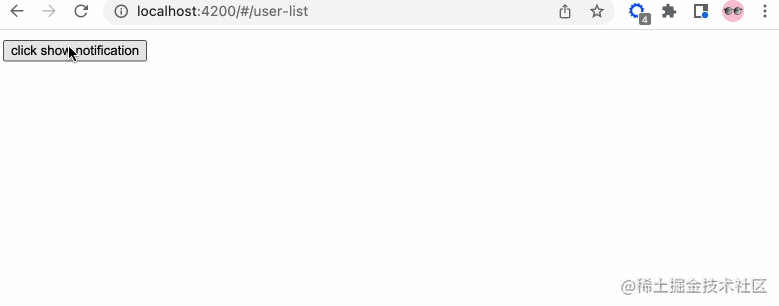
This article will take you to continue learning angular and briefly understand the custom service notification in angular. I hope it will be helpful to everyone!

In the previous article, we mentioned:
service can not only be used to process API requests, but also has other uses
For example, the implementation of notification we are going to talk about in this article. [Related tutorial recommendations: "angular tutorial"]
The rendering is as follows:

UI This can be adjusted later
So, let’s break it down step by step.
We add the notification.service.ts service file in app/services (please use the command Line generation), add relevant content:
// notification.service.ts
import { Injectable } from '@angular/core';
import { Observable, Subject } from 'rxjs';
// 通知状态的枚举
export enum NotificationStatus {
Process = "progress",
Success = "success",
Failure = "failure",
Ended = "ended"
}
@Injectable({
providedIn: 'root'
})
export class NotificationService {
private notify: Subject<NotificationStatus> = new Subject();
public messageObj: any = {
primary: '',
secondary: ''
}
// 转换成可观察体
public getNotification(): Observable<NotificationStatus> {
return this.notify.asObservable();
}
// 进行中通知
public showProcessNotification() {
this.notify.next(NotificationStatus.Process)
}
// 成功通知
public showSuccessNotification() {
this.notify.next(NotificationStatus.Success)
}
// 结束通知
public showEndedNotification() {
this.notify.next(NotificationStatus.Ended)
}
// 更改信息
public changePrimarySecondary(primary?: string, secondary?: string) {
this.messageObj.primary = primary;
this.messageObj.secondary = secondary
}
constructor() { }
}Is it easy to understand...
We will notify into an observable object, and then publish various statuses Information.
We create a new notification component in app/components where public components are stored. So you will get the following structure:
notification ├── notification.component.html // 页面骨架 ├── notification.component.scss // 页面独有样式 ├── notification.component.spec.ts // 测试文件 └── notification.component.ts // javascript 文件
We define the skeleton of notification:
<!-- notification.component.html -->
<!-- 支持手动关闭通知 -->
<button (click)="closeNotification()">关闭</button>
<h1>提醒的内容: {{ message }}</h1>
<!-- 自定义重点通知信息 -->
<p>{{ primaryMessage }}</p>
<!-- 自定义次要通知信息 -->
<p>{{ secondaryMessage }}</p>Then, we simply modify the skeleton and add the following style:
// notification.component.scss
:host {
position: fixed;
top: -100%;
right: 20px;
background-color: #999;
border: 1px solid #333;
border-radius: 10px;
width: 400px;
height: 180px;
padding: 10px;
// 注意这里的 active 的内容,在出现通知的时候才有
&.active {
top: 10px;
}
&.success {}
&.progress {}
&.failure {}
&.ended {}
}success, progress, failure, ended These four class names correspond to the enumeration defined by the notification service. You can add related styles according to your own preferences.
Finally, we add the behavioral javascript code.
// notification.component.ts
import { Component, OnInit, HostBinding, OnDestroy } from '@angular/core';
// 新的知识点 rxjs
import { Subscription } from 'rxjs';
import {debounceTime} from 'rxjs/operators';
// 引入相关的服务
import { NotificationStatus, NotificationService } from 'src/app/services/notification.service';
@Component({
selector: 'app-notification',
templateUrl: './notification.component.html',
styleUrls: ['./notification.component.scss']
})
export class NotificationComponent implements OnInit, OnDestroy {
// 防抖时间,只读
private readonly NOTIFICATION_DEBOUNCE_TIME_MS = 200;
protected notificationSubscription!: Subscription;
private timer: any = null;
public message: string = ''
// notification service 枚举信息的映射
private reflectObj: any = {
progress: "进行中",
success: "成功",
failure: "失败",
ended: "结束"
}
@HostBinding('class') notificationCssClass = '';
public primaryMessage!: string;
public secondaryMessage!: string;
constructor(
private notificationService: NotificationService
) { }
ngOnInit(): void {
this.init()
}
public init() {
// 添加相关的订阅信息
this.notificationSubscription = this.notificationService.getNotification()
.pipe(
debounceTime(this.NOTIFICATION_DEBOUNCE_TIME_MS)
)
.subscribe((notificationStatus: NotificationStatus) => {
if(notificationStatus) {
this.resetTimeout();
// 添加相关的样式
this.notificationCssClass = `active ${ notificationStatus }`
this.message = this.reflectObj[notificationStatus]
// 获取自定义首要信息
this.primaryMessage = this.notificationService.messageObj.primary;
// 获取自定义次要信息
this.secondaryMessage = this.notificationService.messageObj.secondary;
if(notificationStatus === NotificationStatus.Process) {
this.resetTimeout()
this.timer = setTimeout(() => {
this.resetView()
}, 1000)
} else {
this.resetTimeout();
this.timer = setTimeout(() => {
this.notificationCssClass = ''
this.resetView()
}, 2000)
}
}
})
}
private resetView(): void {
this.message = ''
}
// 关闭定时器
private resetTimeout(): void {
if(this.timer) {
clearTimeout(this.timer)
}
}
// 关闭通知
public closeNotification() {
this.notificationCssClass = ''
this.resetTimeout()
}
// 组件销毁
ngOnDestroy(): void {
this.resetTimeout();
// 取消所有的订阅消息
this.notificationSubscription.unsubscribe()
}
}Here, we introduce the knowledge point of rxjs, RxJS is a reactive programming library using Observables, which enables writing Asynchronous or callback based code is easier. This is a great library, and you’ll learn more about it in the next few articles.
Here we use the debounce anti-shake function, function anti-shake means that after the event is triggered, it can only be executed once after n seconds. If it is triggered again within n seconds event, the execution time of the function will be recalculated. To put it simply: when an action is triggered continuously, only the last time is executed.
ps:
throttleThrottle function: Limit a function to be executed only once within a certain period of time.
During the interview, the interviewer likes to ask...
Because this is a global service, we are Call this component in app.component.html:
// app.component.html <router-outlet></router-outlet> <app-notification></app-notification>
In order to facilitate the demonstration, we add a button in user-list.component.html to facilitate the triggering of the demonstration:
// user-list.component.html <button (click)="showNotification()">click show notification</button>
Trigger related code:
// user-list.component.ts
import { NotificationService } from 'src/app/services/notification.service';
// ...
constructor(
private notificationService: NotificationService
) { }
// 展示通知
showNotification(): void {
this.notificationService.changePrimarySecondary('主要信息 1');
this.notificationService.showProcessNotification();
setTimeout(() => {
this.notificationService.changePrimarySecondary('主要信息 2', '次要信息 2');
this.notificationService.showSuccessNotification();
}, 1000)
}At this point, we are done, we have successfully simulated the function of notification. We can modify related service components according to actual needs and customize them to meet business needs. If we are developing a system for internal use, it is recommended to use mature UI libraries. They have already helped us encapsulate various components and services, saving us a lot of development time.
【End】✅
For more programming-related knowledge, please visit: Programming Teaching! !
The above is the detailed content of Angular learning chat notification (custom service). For more information, please follow other related articles on the PHP Chinese website!